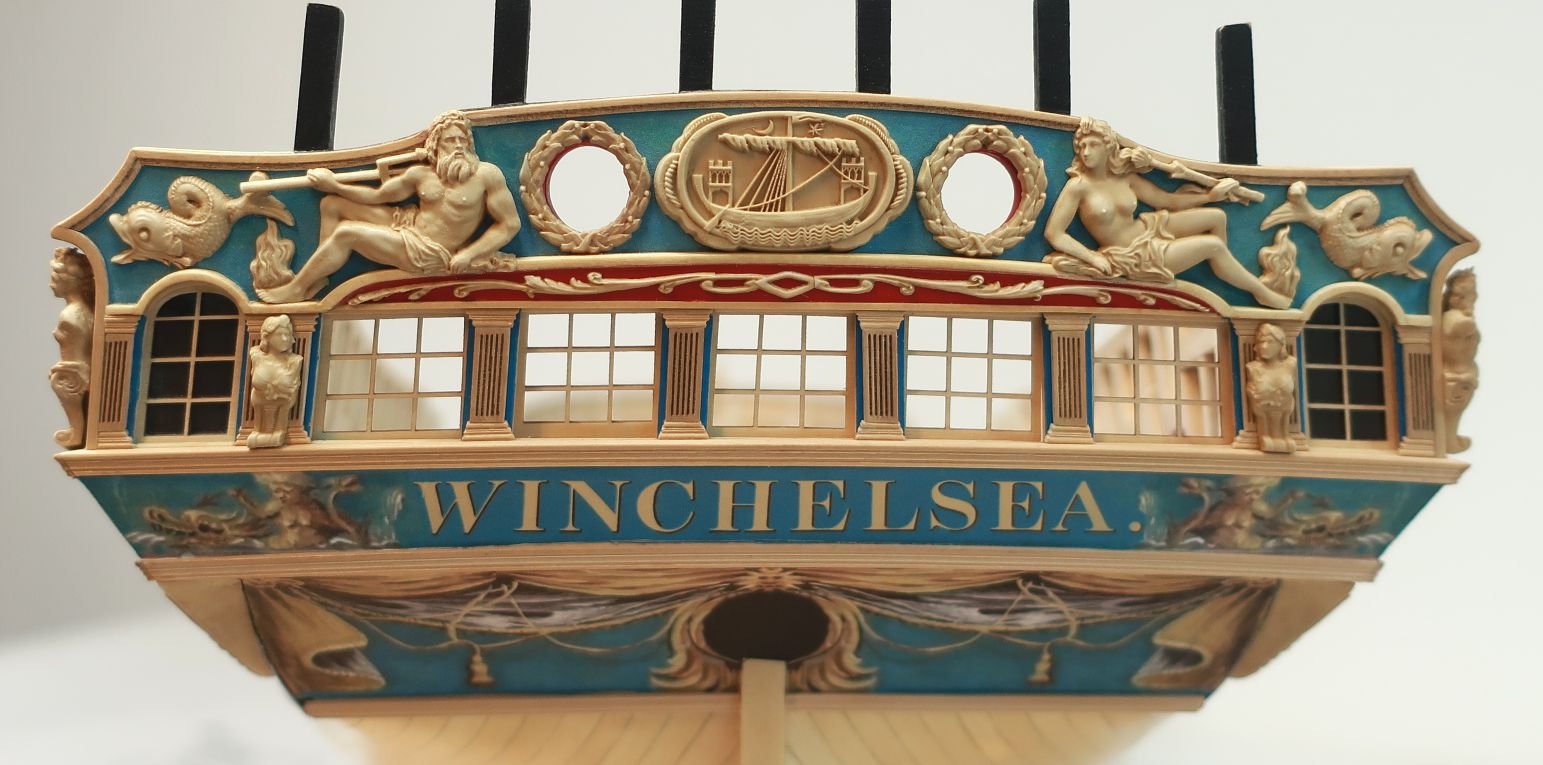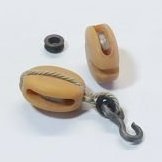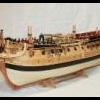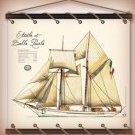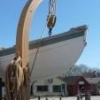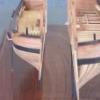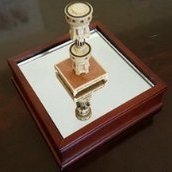-
Posts
9,391 -
Joined
-
Last visited
Reputation Activity
-
 Chuck reacted to Maury S in Cutter Cheerful 1806 by Maury S - 1:48 - POB
Chuck reacted to Maury S in Cutter Cheerful 1806 by Maury S - 1:48 - POB
Ports roughed-in. I made a block 17/32" wide representing the size of the port openings. I put the thinner of each vertical in place on both port and starboard. Then I used the block at each port to determine the thickness of the remaining verticals. Any slight variations in size of verticals was made up in the thicker piece. Lots of bits and pieces from the scrap bin. Chase ports were cut with a razor saw and finished off with a coarse flat rifler file and then 150 grit sanding stick. They all need fairing now.
Maury
-
 Chuck got a reaction from tarbrush in HM Cutter Cheerful 1806 by Chuck - FINISHED - 1:48 scale - kit prototype
Chuck got a reaction from tarbrush in HM Cutter Cheerful 1806 by Chuck - FINISHED - 1:48 scale - kit prototype
I sand a little bit after every four or five planks. Then I apply one coat of wipe-on-poly. It helps to keep it clean with the wipe on poly. Then after the entire side is planked....its sanded down and finished again. Then once again after treenailing.
-
 Chuck got a reaction from john2013 in HM Cutter Cheerful 1806 by Chuck - FINISHED - 1:48 scale - kit prototype
Chuck got a reaction from john2013 in HM Cutter Cheerful 1806 by Chuck - FINISHED - 1:48 scale - kit prototype
I sand a little bit after every four or five planks. Then I apply one coat of wipe-on-poly. It helps to keep it clean with the wipe on poly. Then after the entire side is planked....its sanded down and finished again. Then once again after treenailing.
-
 Chuck got a reaction from Rustyj in HM Cutter Cheerful 1806 by Chuck - FINISHED - 1:48 scale - kit prototype
Chuck got a reaction from Rustyj in HM Cutter Cheerful 1806 by Chuck - FINISHED - 1:48 scale - kit prototype
I sand a little bit after every four or five planks. Then I apply one coat of wipe-on-poly. It helps to keep it clean with the wipe on poly. Then after the entire side is planked....its sanded down and finished again. Then once again after treenailing.
-
 Chuck got a reaction from Canute in HM Cutter Cheerful 1806 by Chuck - FINISHED - 1:48 scale - kit prototype
Chuck got a reaction from Canute in HM Cutter Cheerful 1806 by Chuck - FINISHED - 1:48 scale - kit prototype
Lou,
Basically I just sand the heck out of it to remove any CA that may have absorbed into the wood. Using Boxwood is also an advantage as its dense. The glue doesnt absorb very deep at all. So I am not afraid to sand the hull very smooth and thin down the planking. Typical planking is not a scale 3" thick. In fact, the topside planking above the wales on Cheerful was only 1.5" thick. Its actually noted on the planking draft. So using 1/16" thick strips is way out of scale. This is why I actually used 3/64" thick strips and then sanded them down considerably after I was done which thinned them down to about 1/32" or so. This way you get to the nice clean wood that is blemish-free.
FYI....The wales were 4" thick and the bottom planking under the wales was 2.25" thick as noted on the original planking expansion.
Chuck
-
 Chuck got a reaction from mtaylor in Lanyards for rigging hearts
Chuck got a reaction from mtaylor in Lanyards for rigging hearts
here are some examples....on contemporary models.
-
 Chuck got a reaction from ulrich in Lanyards for rigging hearts
Chuck got a reaction from ulrich in Lanyards for rigging hearts
here are some examples....on contemporary models.
-
 Chuck got a reaction from Ol' Pine Tar in HM Cutter Cheerful 1806 by Chuck - FINISHED - 1:48 scale - kit prototype
Chuck got a reaction from Ol' Pine Tar in HM Cutter Cheerful 1806 by Chuck - FINISHED - 1:48 scale - kit prototype
I sand a little bit after every four or five planks. Then I apply one coat of wipe-on-poly. It helps to keep it clean with the wipe on poly. Then after the entire side is planked....its sanded down and finished again. Then once again after treenailing.
-
 Chuck got a reaction from aviaamator in HM Cutter Cheerful 1806 by Chuck - FINISHED - 1:48 scale - kit prototype
Chuck got a reaction from aviaamator in HM Cutter Cheerful 1806 by Chuck - FINISHED - 1:48 scale - kit prototype
Everything below the wale, I did include the garboard......... I actually have a second planking draft that is slightly different and shows 21....this one is just more clear to post, not to confuse the situation. There are also two deck plans. All original but with slight differences. The important thing to note however is that they are identical in showing no steelers and the one drop plank.
When I started planking, I had two versions of my own plans ready to go....I found that after doing the math, the 20 strake scheme was a perfect match to fit 3/16" wide planks mid ship in two belts. Once the hull was lined off and I divided into two belts, below. Each ten plank belt divided up into perfect 3/16" wide strakes at the center bulkhead.
The break at the square tuck divided the hull perfectly with ten strakes in each belt. Whereas the one that showed 21 strakes would need a funky smaller fraction. Its a lot easier to rip 3/16" wide planks and its a standard wood thickness to buy, so I went with that one.
As a side note....I added the drop plank and the first two strakes in the first belt before I lined off the hull. It just made it easier to do the lining off. Thats why you can see them in the picture while I lined out the hull.
-
 Chuck got a reaction from robin b in HM Cutter Cheerful 1806 by Chuck - FINISHED - 1:48 scale - kit prototype
Chuck got a reaction from robin b in HM Cutter Cheerful 1806 by Chuck - FINISHED - 1:48 scale - kit prototype
Jan wrote:
has nothing to do with actual "real world" planking techniques. In the real world there are no planks wide enough to allow for the amount of spiling required in his method.
Of course, Chucks models look absolutely great, but in my eyes more than perfect, where at least my - beginners - strife is for real world authenticity, I mean, whats the point of making everything above the waterline look absolutely real up to the smallest detail, while the other half the ship (the under water section) is a fiction?
Jan...Not fiction at all.
But I know folks say that steelers and drop planks are just fine and were used historically. That is true....but the huge number of them you see on model ships and explained as the proper way to do it in many books and instruction manuals and practicums. Its just a crutch. So whatever the method.....a hull that looks like this is not something I find attractive or even historically accurate. So I prefer to go for fewer and replicate the way its done on a similar contemporary model or shown in a contemporary draft from the same era. Its just my preference.
I have no intention on picking on the fellow who planked this hull below. But its extreme steelers gone wild and if this is the way he (or you) wants to go its OK. But I find many people using them and only because they find an example where one or two were used historically, and it is just a short rationalization further to go ahead and use 5 or six or even more at the bow and as many at the stern. I disagree entirely. Its just an easy fix and a crutch. I just dont think its accurate or aesthetically pleasing. This is in terms of what we were discussing earlier. I will say this. To plank the hull like this fellow did would probably take longer and be more frustrating than it would to just give lining out a hull a chance. Cutting all of those weird shapes randomly etc.
One drop plank at the bow at most...and no stealers at the stern. That is what I will always shoot for. I think its more accurate and looks better. Not that you wouldnt be able to scour the web for an example or two that is contrary to my opinion. I just think its an excuse to continue to use them willy nilly and in huge numbers rather than learn how to spile and plan a hull's planking. Again, just my opinion. And its Ok. If folks are happy with that, fine, But I just dont buy the argument that this image above is accurate in any way...even if you could find one example that might look a bit like it.
I would rather not get into a lengthy debate about it either because its one of those circular debates. Its just a matter of choosing what you are willing to live with on your project...without trying to force the idea that it must be accurate because one image exists showing something maybe a little similar so...... Then they feel better about using them and wont bother trying to figure it out beyond that. I have had countless discussions on the matter actually. Its more complex than this because it depends on the country of origin, the year, the shape of the bow and hull etc. There is no one size fits all, what kind of ship......... An apple bowed whaler will certainly be planked differently than a sharper cutter or frigate built 75 years earlier and from different countries. Dutch practice vs. English practice. There is just too much to consider for a simple answer..
But I am so lucky because I have this below. Its the planking expansion...just a portion of it so I dont violate any copyright rules...and its for the Cheerful. So I am very comfortable saying its reasonably accurate and the actual ship was closely replicated. Its not fiction at all. The draft shows exactly 20 strakes below the wales. One drop plank only, no steelers. I have no idea how they would have done this in actual practice but there are plenty modeling techniques that can achieve this result. That is if its something you would have fun learning how to do.
-
 Chuck got a reaction from Landlocked123 in HM Cutter Cheerful 1806 by Chuck - FINISHED - 1:48 scale - kit prototype
Chuck got a reaction from Landlocked123 in HM Cutter Cheerful 1806 by Chuck - FINISHED - 1:48 scale - kit prototype
Actually not Jan...The results are pretty accurate, and its not fiction at all. Its just the method I am using is one that is for modeling. Those contemporary models are very accurate to what the ship's really looked like. What I meant was that I have no idea how the original ship builders achieved the results. Its not really important to me. Its the end results that I am trying to replicate.
Notice the crazy bending below. I am sure they started with wider planks....then they applied some crazy bending as well. but the results are the same....no crazy pie-shaped steelers.
Chuck
-
 Chuck got a reaction from fatih79 in HM Cutter Cheerful 1806 by Chuck - FINISHED - 1:48 scale - kit prototype
Chuck got a reaction from fatih79 in HM Cutter Cheerful 1806 by Chuck - FINISHED - 1:48 scale - kit prototype
fortunately I havent had time to finish those last five strakes so I just took some pictures.
Here is a staight plank as if I were going to place it on the hull. It could be at the bow or at the stern. Most beginners would try to force this into place and the top edge of the plank would lift off the hull and not sit flush against the bulkheads. Some fight with it using pins and clamps and it gets messy. Holding it without bending like shown reveals the gap . Note the widest point of that gap.
Mark this location as the center of the gradual curve you will need.
In the next picture, after bending, you can see how nice it fits and how it is flush against the bulkheads. No forcing needed. Its a perfect fit. Note the dot I marked on the plank for the apex of the curve or the widest part of the gap..You could use the compass method or the tape method to find the exact curve, but I prefer to eyeball it like this. Visually its easy to see the curve after a little practice. I always over bend slightly.
Now all I have to do is bevel it a bit and darken the seem as I did in the video and glue it on.
-
 Chuck got a reaction from omete in HM Cutter Cheerful 1806 by Chuck - FINISHED - 1:48 scale - kit prototype
Chuck got a reaction from omete in HM Cutter Cheerful 1806 by Chuck - FINISHED - 1:48 scale - kit prototype
Looking good keith!!!
One of the guys taped my planking session at my club meeting. Its freaky to see myself on a video like this. No laughing. But It shows how I taper and cut a plank to match my plan from lining out the hull. I wish the camera was behind me but I hope its still worth posting.
Chuck
-
 Chuck got a reaction from sonicmcdude in HM Cutter Cheerful 1806 by Chuck - FINISHED - 1:48 scale - kit prototype
Chuck got a reaction from sonicmcdude in HM Cutter Cheerful 1806 by Chuck - FINISHED - 1:48 scale - kit prototype
Here is a look at that "ear" piece. Actually I am not entirely sure it can be called an "ear" as it is only an extension of the molding. But this is indeed what I came up with. Taking a piece 1/16' thick I formed the piece. Its shape was found playing around with a card template. Then I transferred it to the wood. Finally the same scraper I used on the molding was used on this piece. Then a small length of molding was butt against it and continued aft. This is as far as I am going until after I plank and treenail the other side. I did however adjust some of the molding after seeing the pictures I posted yesterday. Some of it had some minor dips and waviness. I feel better now.
Then I will add the stern post and move to the inboard details by planking the bulwarks etc.
Chuck
-
 Chuck got a reaction from tlevine in HM Cutter Cheerful 1806 by Chuck - FINISHED - 1:48 scale - kit prototype
Chuck got a reaction from tlevine in HM Cutter Cheerful 1806 by Chuck - FINISHED - 1:48 scale - kit prototype
Funny you should mention those. I didnt want to start treenailing the other side today. I wanted to wait until after Tuesday which is when I will get a chance to finish that planking. So I added some of the fancy molding. Those thin 1/16" wide strips were the first layer of what would become the fancy molding. It was important to add them below the ports in a special order before the other planking above the wales could be done. This would ensure a proper run of the planks and what would become the second layer of fancy molding.
I actually added that today. They were made as you usually see them, with a scraper. I was very careful to make sure they were very thin. One thing I notice is that folks tend to place molding on their models that is too thick. The molding on the Cheerful is 1/16" wide but less than 1/32" thick. I started with strips that were 1/32" thick and after scraping, I thinned them down even more. It makes for a more delicate look. In hindsight, I could have gone even thinner.
At the bow, the lower molding will carry over onto the stem. But it wont be as I show it in the fourth photo. It should be thicker in the corner between the two so the transition is smooth. But I have only lightly tacked it in this area to show you how it may actually look. I will try and finish that up tomorrow and I will take more pictures. My transition onto the stem with the molding was only a test to check the run of the molding and see how it looks. I will do it for real maybe tomorrow.
Take a look at the contemporary model (last photo) and you will see a standard at the bow (not a molding strip) that will look similar to how I will eventually do it. That is the kind of transition onto the stem I am looking for.
-
 Chuck got a reaction from qwerty2008 in HM Cutter Cheerful 1806 by Chuck - FINISHED - 1:48 scale - kit prototype
Chuck got a reaction from qwerty2008 in HM Cutter Cheerful 1806 by Chuck - FINISHED - 1:48 scale - kit prototype
I sand a little bit after every four or five planks. Then I apply one coat of wipe-on-poly. It helps to keep it clean with the wipe on poly. Then after the entire side is planked....its sanded down and finished again. Then once again after treenailing.
-
 Chuck got a reaction from KenW in HM Cutter Cheerful 1806 by Chuck - FINISHED - 1:48 scale - kit prototype
Chuck got a reaction from KenW in HM Cutter Cheerful 1806 by Chuck - FINISHED - 1:48 scale - kit prototype
I sand a little bit after every four or five planks. Then I apply one coat of wipe-on-poly. It helps to keep it clean with the wipe on poly. Then after the entire side is planked....its sanded down and finished again. Then once again after treenailing.
-
 Chuck got a reaction from GuntherMT in HM Cutter Cheerful 1806 by Chuck - FINISHED - 1:48 scale - kit prototype
Chuck got a reaction from GuntherMT in HM Cutter Cheerful 1806 by Chuck - FINISHED - 1:48 scale - kit prototype
I sand a little bit after every four or five planks. Then I apply one coat of wipe-on-poly. It helps to keep it clean with the wipe on poly. Then after the entire side is planked....its sanded down and finished again. Then once again after treenailing.
-
 Chuck got a reaction from dgbot in HM Cutter Cheerful 1806 by Chuck - FINISHED - 1:48 scale - kit prototype
Chuck got a reaction from dgbot in HM Cutter Cheerful 1806 by Chuck - FINISHED - 1:48 scale - kit prototype
Everything below the wale, I did include the garboard......... I actually have a second planking draft that is slightly different and shows 21....this one is just more clear to post, not to confuse the situation. There are also two deck plans. All original but with slight differences. The important thing to note however is that they are identical in showing no steelers and the one drop plank.
When I started planking, I had two versions of my own plans ready to go....I found that after doing the math, the 20 strake scheme was a perfect match to fit 3/16" wide planks mid ship in two belts. Once the hull was lined off and I divided into two belts, below. Each ten plank belt divided up into perfect 3/16" wide strakes at the center bulkhead.
The break at the square tuck divided the hull perfectly with ten strakes in each belt. Whereas the one that showed 21 strakes would need a funky smaller fraction. Its a lot easier to rip 3/16" wide planks and its a standard wood thickness to buy, so I went with that one.
As a side note....I added the drop plank and the first two strakes in the first belt before I lined off the hull. It just made it easier to do the lining off. Thats why you can see them in the picture while I lined out the hull.
-
 Chuck got a reaction from Nirvana in HM Cutter Cheerful 1806 by Chuck - FINISHED - 1:48 scale - kit prototype
Chuck got a reaction from Nirvana in HM Cutter Cheerful 1806 by Chuck - FINISHED - 1:48 scale - kit prototype
fortunately I havent had time to finish those last five strakes so I just took some pictures.
Here is a staight plank as if I were going to place it on the hull. It could be at the bow or at the stern. Most beginners would try to force this into place and the top edge of the plank would lift off the hull and not sit flush against the bulkheads. Some fight with it using pins and clamps and it gets messy. Holding it without bending like shown reveals the gap . Note the widest point of that gap.
Mark this location as the center of the gradual curve you will need.
In the next picture, after bending, you can see how nice it fits and how it is flush against the bulkheads. No forcing needed. Its a perfect fit. Note the dot I marked on the plank for the apex of the curve or the widest part of the gap..You could use the compass method or the tape method to find the exact curve, but I prefer to eyeball it like this. Visually its easy to see the curve after a little practice. I always over bend slightly.
Now all I have to do is bevel it a bit and darken the seem as I did in the video and glue it on.
-
 Chuck reacted to edmay in Meet Your NRG Directors and Officers
Chuck reacted to edmay in Meet Your NRG Directors and Officers
Being part of a prestigious group of extraordinary folk who give there time ,experience and knowledge for the betterment of all ship modeller's are to be highly praise worthy. Your contributions are certainly appreciated and I thank you all. Edwin
-
 Chuck got a reaction from mtaylor in HM Cutter Cheerful 1806 by Chuck - FINISHED - 1:48 scale - kit prototype
Chuck got a reaction from mtaylor in HM Cutter Cheerful 1806 by Chuck - FINISHED - 1:48 scale - kit prototype
Lou,
Basically I just sand the heck out of it to remove any CA that may have absorbed into the wood. Using Boxwood is also an advantage as its dense. The glue doesnt absorb very deep at all. So I am not afraid to sand the hull very smooth and thin down the planking. Typical planking is not a scale 3" thick. In fact, the topside planking above the wales on Cheerful was only 1.5" thick. Its actually noted on the planking draft. So using 1/16" thick strips is way out of scale. This is why I actually used 3/64" thick strips and then sanded them down considerably after I was done which thinned them down to about 1/32" or so. This way you get to the nice clean wood that is blemish-free.
FYI....The wales were 4" thick and the bottom planking under the wales was 2.25" thick as noted on the original planking expansion.
Chuck
-
 Chuck got a reaction from jay in HM Cutter Cheerful 1806 by Chuck - FINISHED - 1:48 scale - kit prototype
Chuck got a reaction from jay in HM Cutter Cheerful 1806 by Chuck - FINISHED - 1:48 scale - kit prototype
Looking good keith!!!
One of the guys taped my planking session at my club meeting. Its freaky to see myself on a video like this. No laughing. But It shows how I taper and cut a plank to match my plan from lining out the hull. I wish the camera was behind me but I hope its still worth posting.
Chuck
-
 Chuck got a reaction from KenW in HM Cutter Cheerful 1806 by Chuck - FINISHED - 1:48 scale - kit prototype
Chuck got a reaction from KenW in HM Cutter Cheerful 1806 by Chuck - FINISHED - 1:48 scale - kit prototype
Lou,
Basically I just sand the heck out of it to remove any CA that may have absorbed into the wood. Using Boxwood is also an advantage as its dense. The glue doesnt absorb very deep at all. So I am not afraid to sand the hull very smooth and thin down the planking. Typical planking is not a scale 3" thick. In fact, the topside planking above the wales on Cheerful was only 1.5" thick. Its actually noted on the planking draft. So using 1/16" thick strips is way out of scale. This is why I actually used 3/64" thick strips and then sanded them down considerably after I was done which thinned them down to about 1/32" or so. This way you get to the nice clean wood that is blemish-free.
FYI....The wales were 4" thick and the bottom planking under the wales was 2.25" thick as noted on the original planking expansion.
Chuck
-
 Chuck got a reaction from qwerty2008 in HM Cutter Cheerful 1806 by Chuck - FINISHED - 1:48 scale - kit prototype
Chuck got a reaction from qwerty2008 in HM Cutter Cheerful 1806 by Chuck - FINISHED - 1:48 scale - kit prototype
Lou,
Basically I just sand the heck out of it to remove any CA that may have absorbed into the wood. Using Boxwood is also an advantage as its dense. The glue doesnt absorb very deep at all. So I am not afraid to sand the hull very smooth and thin down the planking. Typical planking is not a scale 3" thick. In fact, the topside planking above the wales on Cheerful was only 1.5" thick. Its actually noted on the planking draft. So using 1/16" thick strips is way out of scale. This is why I actually used 3/64" thick strips and then sanded them down considerably after I was done which thinned them down to about 1/32" or so. This way you get to the nice clean wood that is blemish-free.
FYI....The wales were 4" thick and the bottom planking under the wales was 2.25" thick as noted on the original planking expansion.
Chuck

